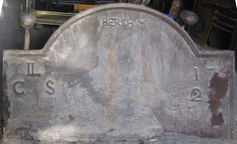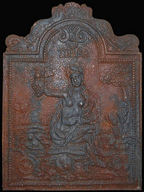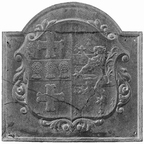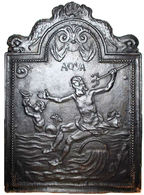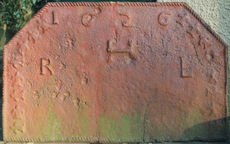-
872
Description: Arched rectangular shape; rebated fillet edging (top and sides); word 'BERSHAM' (AM ligature) in arch; initials triad 'C LL S' (LL ligature) in left shoulder; date on two lines in right shoulder.
Notes: The initials are likely to be those of Charles Lloyd of Dolobran, Montgomeryshire, and Sarah (née Crowley) his wife. Lloyd ran Bersham Furnace, near Wrexham, from 1710 until 1728. Smelting iron with coke began at Bersham in 1721, so it is likely that this fireback was made of coke-smelted iron.
Inscription: BERSHAM / LL 17 / C S 22
- Decoration tags:
- rectangular with round arch (shape)
- rebated fillet (edging)
- carved stamps
- individual letters
- individual numbers
- text
Manufactured: in 1722 at Bersham Furnace in the North Wales area of Wales.
Current location: Wrexham Museum, Wrexham, Clwyd, Wales.
(part of the Wrexham County Borough Museums museum group)
- Attached to series:
- Date & initials firebacks
-
877
Description: Low arched rectangle; astragal and stepped fillet edging; slanted shield, helm and mantling; crest missing; at bottom, date split either side of shield.
Notes: The arms are of the Pollen family of Redenham, Hampshire; blazon: azure, on a bend cotised or between six lozenges argent each charged with an escallop sable, five escallops vert.
Inscription: 19 27
Arms: Pollen of Andover, Hampshire
- Decoration tags:
- rectangular with round arch (shape)
- astragal and stepped fillet (edging)
- whole carved pattern
- armorial
Manufactured: in 1927 in England.
Current location: not known.
- Attached to series:
- Personal armorial firebacks
-
908
Description: Quasi arched rectangular shape with detached pediment above symmetrical ‘horns’ within arcs; cavetto-moulded edging; shield with helm, crest and mantling; initials split by crest.
Notes: Blazon: quarterly 1st lion rampant (poss. Lewis, descendant of Gwaethfoed); 2nd a chevron between three fleurs de lys (descendant of Einon ap Collwyn); 3rd three chevronels (descendant of Iestyn ap Gwrgan); 4th as 2nd (but possibly different tinctures); crest: a lion rampant; the initials suggest the arms may be of a member of a cadet branch of the Lewis family.
Inscription: T L
Arms: Possibly a member of the Lewis family
- Decoration tags:
- rectangular with detached pediment (shape)
- cavetto (edging)
- whole carved pattern
- armorial
- text
Manufactured: in the late-16th to early-17th century in Wales.
Current location: Ty-r-ash, Brecon Road, Crickhowell, Powys, Wales.
- Attached to series:
- Personal armorial firebacks
- Welsh armorial firebacks
-
904
Description: Arched rectangular shaped central panel with five-bead and open pellet edging; pictorial: regal figure in his chariot drawn by two horses, a sceptre in his right hand; above, a putto descends from swagged curtains and a pair of tassels; below is a landscape with a cornucopia; arched rectangular shaped border with fillet edging, a scallop shell top centre with symmetrical arrangement of ivy and acanthus leaves and tendrils; the initial, N, in a cartouche bottom centre, between symmetrical oak fronds, leaves and acorns; above is a symmetrical design of scrolled floral tendrils terminating in sea monsters.
Notes: Very similar in design and execution to firebacks of the SHR and EB series, suggesting designs emanating from the same source and with a similar inspiration. The figure in the chariot may be an allegory of the Sun. Apollo is traditionally drawn by horses.
Copies of this fireback are known.
Inscription: N
- Decoration tags:
- 'Dutch' (shape)
- fillet (edging)
- whole carved pattern
- allegorical
- animals
- humans
- plants
- objects
Manufactured: in the early-18th century in England.
Current location: not known.
- Attached to series:
- N series
- British 'Dutch' style firebacks
-
905
Description: Canted rectangle; fillet edging (top and sides); date to full width across centre of plate.
Notes: Bold, evenly-spaced numerals.
Inscription: 1680
- Decoration tags:
- rectangular with canted top corners (shape)
- fillet (edging)
- individual numbers
- text
Manufactured: in 1680 in England.
Current location: in private hands, Vauxhall, London, England.
- Attached to series:
- Date only firebacks
- 1680s Canted series
-
253
Description: Arched rectangular shape; cavetto moulded edging; garter enclosing Stuart royal arms, with supporters, crown and motto; date split either side of garter buckle; rectangular extension panel at bottom.
Notes: An altered casting from a 1641 original (no. 445), the last part of the date having disproportionate numerals; often copied. From the detail of the relief, probably an early casting.
Copies of this fireback are known.
Inscription: C R / HONI SOIT QVI MAL Y PENSE / 16 64 / DIEV ET MON DROIT
Arms: English Stuart royal
- Decoration tags:
- rectangular with round arch (shape)
- cavetto (edging)
- whole carved pattern
- individual numbers
- extension panels
- armorial
- royal
- text
Manufactured: in 1664 possibly in the Weald area of England.
Current location: not known.
- Attached to series:
- Carolean royal armorial firebacks
- Stuart royal armorial firebacks
- Royalist series
-
948
Description: Arched rectangular shaped central panel with bead edging; seated, semi-naked female figure, with laurels leaves about her head, holding a bunch of grapes in her raised right hand; she is sitting on a stool; to her right is what appears to be a pile of stones; to her left a vase of tulips with a tree behind; above centre, is the word TERRA (earth - Latin); above is a swag of drapery enclosing a scallop shell; outside the panel is a narrow border of the same shape with fillet edging; the fireback is surmounted by a scallop shell between two outward-facing sea serpents.
Notes: One of a series of four designs of the classical elements of Earth, Air, Fire and Water.
Copies of this fireback are known.
Inscription: TERRA
- Decoration tags:
- 'Dutch' (shape)
- whole carved pattern
- pictorial
- allegorical
- text
- humans
- plants
Manufactured: in the mid- to late-17th century possibly in the Siegerland area of Germany.
Current location: not known.
- Attached to series:
- 'Dutch' Miscellaneous Firebacks
- Elements firebacks
-
1054
Description: Arched rectangular shape; chamfered edging; 'renaissance' style shield with floriate decoration; incised heraldic design.
Notes: The arms are of Sir John Herbert Vernon Bt. impaling those of his wife, Elizabeth Bagnall; Blazon: (Vernon) Or, on a fess azure between two crosses moline gules three garbs of the field, a canton of a baronet; (Bagnall) Ermine, two bars or, over all a lion rampant azure. The fireback dates from between 1919, when Sir John inherited the baronetcy and his death in 1933.
Arms: Vernon impaling Bagnall
- Decoration tags:
- rectangular with round arch (shape)
- chamfered (edging)
- whole carved pattern
- heraldic
- armorial
Manufactured: in the early-20th century in England.
Current location: not known.
- Attached to series:
- Personal armorial firebacks
-
947
Description: Arched rectangular shaped central panel with bead edging; naked figure of Poseidon/Neptune holding a a trident in his raised left hand, his right arm extended; he is sitting on a bridge over a flowing stream; to his right a merman, half immersed, blows a shell trumpet; above centre, is the word AQUA (water - Latin); above is a swag of drapery enclosing a scallop shell; outside the panel is a narrow border of the same shape with fillet edging; the fireback is surmounted by a scallop shell between two outward-facing sea serpents.
Notes: One of a series of four designs of the classical elements of Earth, Air, Fire and Water.
Copies of this fireback are known.
Inscription: AQUA
- Decoration tags:
- 'Dutch' (shape)
- fillet (edging)
- whole carved pattern
- pictorial
- mythological
- allegorical
- text
- humans
- objects
Manufactured: in the mid- to late-17th century possibly in the Siegerland area of Germany.
Current location: not known.
- Attached to series:
- 'Dutch' Miscellaneous Firebacks
- Elements firebacks
-
956
Description: Canted rectangle; twisted rope edging; date along the top; initials in triad across the middle; fleur-de-lys stamp repeated eight times down each side, pointing to the side or up in the order (from the top): side (2), then alternately, up first.
Notes: The initials probably represent those of a married couple, the 'H' for their surname; it is unusual for twisted rope edging to continue along the bottom of the plate.
Inscription: 1626 / RHL
- Decoration tags:
- rectangular with canted top corners (shape)
- rope (edging)
- carved stamps
- individual letters
- individual numbers
- heraldic
- text
Manufactured: in 1626 in the Forest of Dean area of England.
Current location: not known.
- Attached to series:
- Date & initials firebacks
- 1620s Dean series
